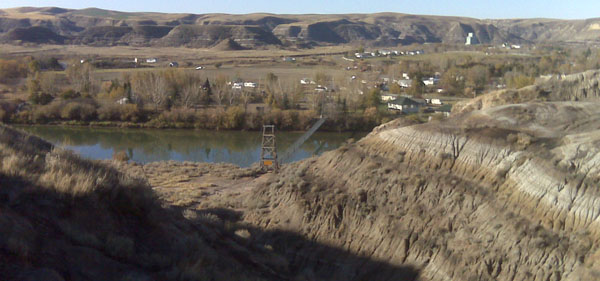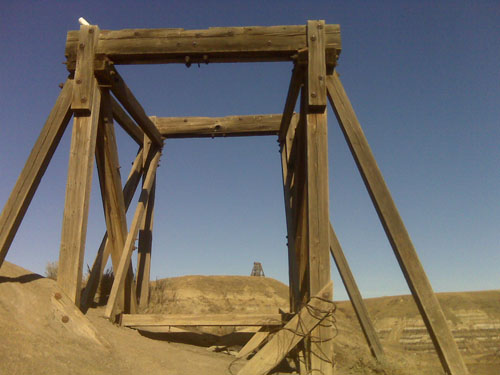PARKING:
N51 25.179 W112 36.937
|

Coal Mining in the Drumheller Valley
Coal was not hard to discover in the area that is now
Drumheller, Alberta, Canada. Seams of coal show up as black stripes
in the badlands of the Red Deer River Valley.
The Blackfoot and Cree knew about the black rock that burned,
but they didn't like to use it. Later, three white explorers
reported coal in the area: Peter Fidler in 1792, Dr. James Hector
of the Palliser Expedition in 1857, and Joseph Tyrrell in 1884.
In the years that followed, a handful of ranchers and
homesteaders dug coal out of river banks and coulees to heat their
homes. However, the first commercial coal mine did not open until
Sam Drumheller started the coal rush in the area that now bears his
name.
The rush started when Sam bought land off a local rancher named
Thomas Greentree. Sam turned around and sold this land to Canadian
National Railway, to develop a townsite. Sam also registered a coal
mine. Before his mine opened, however, Jesse Gouge and Garnet Coyle
beat him to it, and opened the Newcastle Mine. CN laid tracks into
town, and the first load of coal was shipped out of Drumheller in
1911.
Once the railway was built, people poured in. Hundreds, then
thousands, of people came to dig coal. The greatest numbers came
from Eastern Europe, Britain, and Nova Scotia. More mines opened.
By the end of 1912, there were 9 working coal mines, each with its
own camp of workers: Newcastle, Drumheller, Midland, Rosedale, and
Wayne. In the years that followed, more mines and camps sprang up:
Nacmine, Cambria, Willow Creek, Lehigh, and East Coulee.

Coal mining was hard, dirty, dangerous work. Mining in the
Drumheller Valley, however, was less hard, dirty, and dangerous
than it was in many other coal mining regions in Canada. This was
due to both lucky geology and lucky timing.
The geology of the Drumheller coal field results in flat lying
seams, which are much safer to mine than the steeply pitching seams
of the mountain mines. In addition, the coal produced in Drumheller
is sub-bituminous. This grade of coal is "immature" which means it
hasn't had time to build up a strong concentration of gas. Methane
gas is the biggest killer in coal mines around the world.
The timing of the Drumheller mine industry was lucky, too. By
the time the Newcastle opened in 1911, the right to better working
conditions had been fought for and won by miners' unions in North
America. As a result, miners were provided with wash houses, better
underground ventilation, and higher safety standards. When the
Newcastle opened, there were laws in place to prohibit child
labour, so boys under 14 were no longer allowed underground. The
worst of the worst coal mining days were over, at least in North
America.
Nevertheless, early mine camps around Drumheller were called
"hell's hole" because miners lived in tents, or shacks, with little
sanitation and little comfort. It was a man's world, with drinking,
gambling, and watching fistfights common forms of recreation. As
shacks gave way to little houses, and women joined the men and
started families, life improved. Hockey, baseball, music, theatre,
and visiting friends enriched peoples' lives. Going downtown
Saturday night was a huge event, with every language in Europe
spoken by the crowds spilling off the sidewalks. No longer "hell's
hole," Drumheller became "the wonder town of the west!" and "the
fastest growing town in Canada, if not in North America!"

Sub bituminous coal is ideal for heating homes and cooking food.
People all over western Canada heated their homes, schools, and
offices with Drumheller coal. Long, cold winters were good for
Drumheller, because everyone needed lots of coal. In these years,
miners had of money in their pockets. Short, mild winters were
difficult. A miner might only work one day a week, and get laid off
in early spring. He got through the summer by growing a big garden,
catching fish, and working for farmers.
Between 1911 and 1979, 139 mines were registered in the
Drumheller valley. Some mines didn't last long, but 34 were
productive for many years. Between 1912 and 1966, Drumheller
produced 56,864,808 tons of coal, making it one of the major coal
producing regions in Canada.
The beginning of the end for Drumheller's mining industry was
the Leduc Oil Strike of 1948. After this, natural gas became the
fuel of choice for home heating in western Canada. To the mine
operators, it seemed that people switched from messy coal stoves to
clean gas furnaces as fast as they could. As the demand for coal
dropped, mines closed. As mines closed, people moved away and
communities suffered. Some communities, like Willow Creek,
completely vanished. Others, like East Coulee, went from a boomtown
of 3800 to a ghost town of 180. When the Atlas #4 Mine shipped its
last load of coal in 1979, the coal years of Drumheller were
over.
This site is helping preserve the last of the Drumheller mines
and recall the time when Coal was King, and "mining the black"
brought thousands of people to this lonely valley.
Coal
Coal is a combustible sedimentary rock formed from the remains
of plant life and comprises the world's largest fossil energy
resource. It is located primarily in the Northern Hemisphere. Coal
is not a uniform substance; rather, it is a wide variety of
minerals with different characteristics arising from the nature of
its vegetation source and siltation history and from the time and
geological forces involved in its formation (including temperature
and pressure).
Coal is classified according to 4 ranks or classes, each
subdivided according to fixed carbon and volatile matter content
and heating value. The anthracite class, the most valuable, is
blended with bituminous coals to make coke for the iron and steel
industry and is also used in the chemical industries. Bituminous
coal, besides its use in steelmaking, is used as thermal coal for
electric-power generation. Subbituminous coal supplies
thermal-power fuel and steam for industry, and can be used in coal
gasification and coal liquefaction.
The lowest grade of coal, lignite, is used for the same purposes
as subbituminous coal.
Reference: Atlas Coal Mine National Historic Site

To log this earthcache:
- Email me the year was this mine closed and what capacity it had
for producing Lignite?
- Take a picture of yourself and/or your GPSr at the posted
coordinates with the 2 structures in the background.
LOGS WILL BE DELETED IF YOU DO NOT UPLOAD A PICTURE WITHIN 7
DAYS! |
Avoid going here when it rains or snows as it can be extremely
slippery. Also note there is free parking and no charge to be in
this area or cross the bridge.